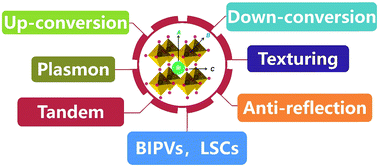Photon management to reduce energy loss in perovskite solar cells
Abstract
Despite the rapid development of perovskite solar cells (PSCs) over the past few years, the conversion of solar energy into electricity is not efficient enough or cost-competitive yet. The principal energy loss in the conversion of solar energy to electricity fundamentally originates from the non-absorption of low-energy photons ascribed to Shockley–Queisser limits and thermalization losses of high-energy photons. Enhancing the light-harvesting efficiency of the perovskite photoactive layer by developing efficient photo management strategies with functional materials and arrays remains a long-standing challenge. Here, we briefly review the historical research trials and future research trends to overcome the fundamental loss mechanisms in PSCs, including upconversion, downconversion, scattering, tandem/graded structures, texturing, anti-reflection, and luminescent solar concentrators. We will deeply emphasize the availability and analyze the importance of a fine device structure, fluorescence efficiency, material proportion, and integration position for performance improvement. The unique energy level structure arising from the 4fn inner shell configuration of the trivalent rare-earth ions gives multifarious options for efficient light-harvesting by upconversion and downconversion. Tandem or graded PSCs by combining a series of subcells with varying bandgaps seek to rectify the spectral mismatch. Plasmonic nanostructures function as a secondary light source to augment the light-trapping within the perovskite layer and carrier transporting layer, enabling enhanced carrier generation. Texturing the interior using controllable micro/nanoarrays can realize light–matter interactions. Anti-reflective coatings on the top glass cover of the PSCs bring about better transmission and glare reduction. Photon concentration through perovskite-based luminescent solar concentrators offers a path to increase efficiency at reduced cost and plays a role in building-integrated photovoltaics. Distinct from other published reviews, we here systematically and hierarchically present all of the photon management strategies in PSCs by presenting the theoretical possibilities and summarizing the experimental results, expecting to inspire future research in the field of photovoltaics, phototransistors, photoelectrochemical sensors, photocatalysis, and especially light-emitting diodes. We further assess the overall possibilities of the strategies based on ultimate efficiency prospects, material requirements, and developmental outlook.



 Please wait while we load your content...
Please wait while we load your content...